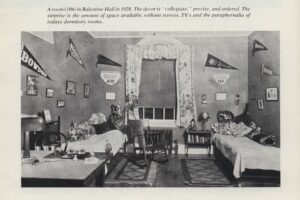
The works of 15 studio art capstone students are currently on display at the Lord Hall Gallery. Presented by the University of Maine Department of Art, this exhibition titled “Multifarious: Artists in Flux” will run through Feb. 3.
Multifarious is synonymous to diverse, which rightfully describes this senior arts exhibition. Featuring 85 works of art, the show displays such media as painting, sculpture, illustration, photography, print, ceramic, digital art in the form of painting, animation and interactive media.
This exhibition is a requirement for ART 499, which is titled “Studio Art Senior Capstone.” Students wishing to graduate with a B.A. in studio art have to display the culmination of their studies in this show. This is the only studio art class where students do not make studio art. Instead, this capstone course focuses on many behind the scenes aspects of being an artist.
In the first half of the course, students discussed a number of things related to graduating with a degree in studio art, as well as what happens next. Students worked on their resumes, wrote artist statements, interviewed career professionals, visited studios and galleries of their interest and learned how to make the transition from college to the business of art.
The second half of the course revolved around putting on “Multifarious: Artists in Flux.” Everything about the show was done by the students. Lighting, installing, matting and framing, even things like advertising and catering for opening night, all of these responsibilities were on students’ shoulders. Linehan took on the role of a facilitator in this process, giving advice and providing assistance when needed.
One of Linehan’s primary goals was to teach students the industry’s standards of presenting their art.
“You don’t want the way it’s presented to be the story, you just want it to look nice, to optimize the way your look at the work,” Linehan said. “Almost every man looks good in a tuxedo, similarly, good presentation makes the work look good.”
Students had to pay a lot of attention to things that tend to be overlooked by viewers. One of them was making sure that frames were hung on the average eye-level (58 inches). Another aspect of a successful exhibition is allowing the art to speak for itself. To achieve that, students chose white or off-white matting and black or wooden frames for all of the framed pieces.
“If it’s [the show] done well, you don’t notice it, you have the feeling that it just feels nice,” Linehan said. “You can take the same bunch of work and make it an ugly show. Our goal is to make it pleasant, to have a flow and as good looking as it can be.”
Artists and curators have to consider that bright and colorful pieces should have colorful pieces next to them. Following such work with neutral pieces creates too harsh of a transition for the viewer’s eye.
At the foyer of Lord Hall, a black and white 9-by-12 foot canvas by Jessie Hardy is on display. Hardy, who used house paint to create that piece, chose a monochrome theme because it is more economical. Two of her abstract black and white collages from the series “Psychology Form Study” were chosen to be displayed at President Susan Hunter’s office. Another piece that will go to Hunter’s office is a large scale woodcut piece by Hannah Hooke. Also black and white, this piece was inspired by Hooke’s semester abroad in Japan.
“I feel pretty excited and proud of that accomplishment,” Hardy said. After graduating in May, 2018, Hardy plans to study art therapy in graduate school and become a mental health counselor.
One of the art techniques displayed at the exhibition is intaglio. A form of printmaking, intaglio is
a process of embossing the paper into the incised lines of a printing surface. Hattie Stiles displayed two prints created through the intaglio process.
“I like working with really fine lines,” Stiles said. “I tend to overwork things, doing small areas a time. With intaglio, you get to see your work slowly improve as you learn more about the process.”
Amy Sutherland got to showcase her passion for photography in a suite of six photographs of nature and animals, including her dog Lassie.
“She [Lassie] was definitely an interesting subject to capture,” Sutherland said. Her advice for current art students would be to keep making art every day. “That’s how you grow as an artist, try everything. You never know what you like until you find that thing you’re passionate about.”









